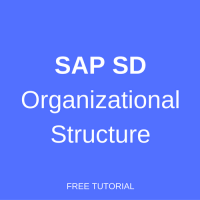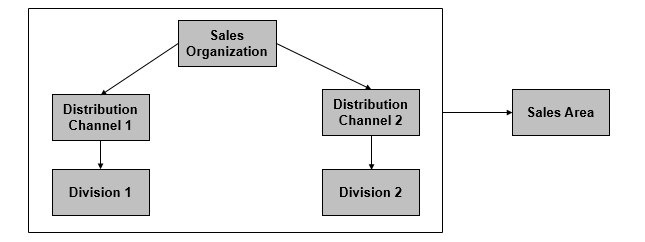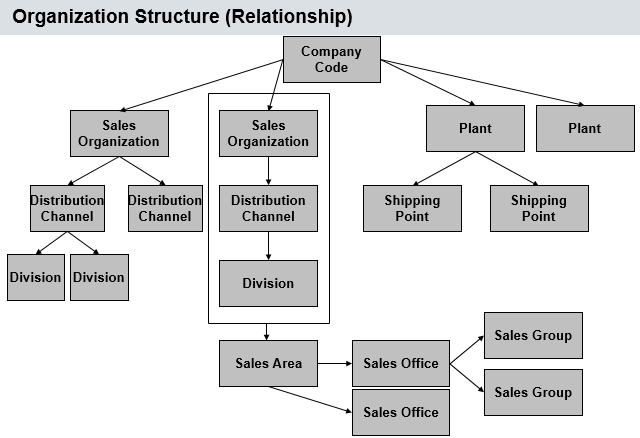 This tutorial is part of SAP SD training course and it explains about SAP SD organizational structure. After following the tutorial, you will learn how to model enterprise structure in SAP SD (Sales and Distribution) module of SAP ERP. Knowledge of SAP SD organizational structure is fundamental for analysts and consultants that specialize in SAP SD and here you will learn about each the SD organizational units.
This tutorial is part of SAP SD training course and it explains about SAP SD organizational structure. After following the tutorial, you will learn how to model enterprise structure in SAP SD (Sales and Distribution) module of SAP ERP. Knowledge of SAP SD organizational structure is fundamental for analysts and consultants that specialize in SAP SD and here you will learn about each the SD organizational units.
Target Audience of this Article
- Readers interested in learning about SAP SD
- SAP Consultants already having experience in other SAP’s module other than Sales & Distribution and are interested in learning more about SAP Sales & Distribution
- Clients or Users at user end willing either implementing SAP or will be implementing SAP in the future to understand jargons which SAP Consultants use
Foreword
Like any other organization’s structure, be it the reporting structure mentioned in the organizational chart, departmental structure, reporting hierarchy, signing mandate hierarchy, processes and procedurals structure; which is mandatory for smooth processing of business processes. Hence, SAP ERP has its own organizational structure. Every module of SAP has its own enterprise structure. Enterprise structure helps in building a hierarchy and structure to streamline the business processes.
Before initiating implementation, designing and configuring the actual system, Enterprise Structure is defined in the Business Blueprint documentation phase. It is an important step is to define the organizational structures. It requires thorough analysis of how your organization currently runs and the business wants to run its business after implementation of SAP.
If the organization is huge, dealing with multiple line of businesses, its processes are complex and if it is scattered geographically at different locations within the country, region, continent or globe; designing and finalizing the Enterprise Structure is a very critical, vital and time taking activity. Several meetings can be called with the Business Process Owners and Subject Matter Experts to finalize the Enterprise structure which may also require endorsement and approval from the higher management. Sometimes sign off on SAP Enterprise Structure is obtained separately during the Business Blueprinting phase.
SAP SD Organizational Structure
In the SAP ERP, several structures can be used to represent the legal and organizational structure of the company. Organizational elements can be structured from the point of view of accounting, materials management and sales and distribution. It is possible to combine these structures. The organizational structures form a framework in which all business transactions can be processed.
Following organizational units represents Sales and Distribution module:
- Sales Organization
- Distribution Channel
- Division
Sales and Distribution module uses some other organizational units which are maintained by other module in SAP, such as:
- Company Code (Finance Module)
- Plant (Material Management Module)
- Storage Location (Material Management Module)
The organizational units discussed below are relevant to SAP Sales and Distribution only.
Graphical Overview of Enterprise Structure in SAP Sales & Distribution

Company Code
Company Code in SAP is the organizational unit which is the created in Finance (FI) module and same is linked with Sales & Distribution module. Company Code represents an independent company. Company which is a legal entity and statutory requirement is to maintain Balance Sheet and Profit and Loss Statement are created and maintained at the Company Code level.
In a scenario where the model is that a corporate group or group of companies are carrying out their businesses in different sectors of economy, every Company by law is a legal entity which is liable to maintain separate book of accounts. All books of accounts are maintained at Company Code level.
Sales Organization
Sales Organization in SAP Sales & Distribution module is at the highest level in organizational structure and is primarily responsible for carrying out and monitoring sales. Sales Organization is responsible for devising sales strategies which are to be executed to gain market share.
If there are any Customer’s complaints regarding the goods and services which the company primarily is responsible for, all such queries and complaint handling is done at Sales Organization level. A Sales Organization is assigned to a unique Company Code. If the business is of such nature, one or more Sales Organizations can be created and assigned to a Company Code.
All the sales reporting is accumulated at Sales Organization level. Reporting is carried out by Sales Organization. If you want to see sales performance of one sector your business, you will select the Sales Organization and all the sales pertaining to the select Sales Organization will be displayed.
All Sales and Distribution documents are assigned to a single Sales Organization. If you want to use SAP SD, at least one Sales Organization must exist.
Distribution Channel
A Distribution Channel in simple terms refer to your strategy how you penetrate in the market with you offering either product or a service or both. It is your mean how you would like to reach to your customer or end consumer. Examples of Distribution Channel can be, but not limited to; Sales to Wholesale Customers, Retail sales, Institutional sales, Internet sales, Employee Sales, Fair Price Shop, etc.
Different categories of Customers can be reached through one or more Distribution Channels within a Sales Organization. To proceed with sales processing, at least one Distribution Channel is required.
Division
Division is used to group certain nature of goods and services which share some traits or properties. It also serves and represents the product line of your business. When executing sales in SAP Sales and Distribution, at least one division should be available in the SAP system. Materials which are sold to the customer should be assigned to a division.
Example we can take is of any automobile dealer having offering 3s services. Namely: Sales (of cars new or used), Service and Spare parts.
Sales Area

In SAP Sales and Distribution, Sales Area is just a of combination of Sales Organization, Distribution Channel and Division. It defines that a certain Sales Organization employed certain strategy of market reach i.e. a Distribution Channel to sale a good or service belonging to a certain division.
Every sales document in SAP Sales and Distribution is assigned to a single Sales Area. Sales reporting can be further refined or drilled when you restrict and select a certain Sales Area in the SAP system.
Plant
Plant in the SAP system is broader term which has a varying definition when different logistics modules come into discussion.
- In Materials Management (MM) module, Plant is referred to facility where the material stock is kept, stored and inventory is maintained
- In Production Planning (PP) module, Plant is referred to a production facility where the production of goods is done
- In Sales and Distribution (SD) module, Plant is a facility from where the finished product is distributed or dispatched to customer
In SAP Sales and Distribution, to proceed with the sales and dispatching, one Plant is required.
Storage Location
Storage Location is an organization unit in logistics which assigned to a Plant where the stock is kept. Storage Location can be characterized and vary based on their properties like Raw Material Storage Location, Finished Goods Storage Location, Spares Storage Location, Returns Sales Storage Location, Temperature Controlled Storage Location, etc.
Shipping Point
For shipping the product to the customer, Shipping Point is required. Shipping Point is assigned to a Plant. A Plant can have several shipping points based on the dispatch activities required for the shipping. For instance, some materials are fragile in nature and require extra care while dispatching maybe it requires manual labor or a product which is heavy in nature and require tools such as fork lifter or crane.
Several Plants can have one Shipping Point provided if they are physically located within the same vicinity.
Sales Office
Business often setup several Sales Offices apart from the head office or headquarters to reach the market in depth. These Sales Offices are often located at different geographical areas. Sales reporting can be executed with Sales Office organizational unit to analyze the performance of Sales Offices. It basically acts as a liaison office between Company’s headquarters, sales department and the Customer.
Sales Group
Employees belonging to certain Sales Office can be referred as Sales Groups. These Sales Groups are assigned to their respective Sales Offices. It is a subset of Sales Office.
Graphical Overview of Extended SAP SD Organizational Structure

—
Did you like this tutorial? Have any questions or comments? We would love to hear your feedback in the comments section below. It’d be a big help for us, and hopefully it’s something we can address for you in improvement of our free SAP SD tutorials.
Navigation Links
Go to next lesson: How to Create SAP SD Inquiry
Go to overview of the course: Free SAP SD Training

Very clear explanation. Good to remmember what was viewed on course.
hello excuse me where the relationship between salesorginaztion and plant
plant and storage location
i am sorry for my english
thanks
A plan is assigned to a combination of a sales organization and a distribution channel. More information in this tutorial: Assignment of Plant to Sales Organization and Distribution Channel.
Its really very good and good explanation even freshers can understand easily
Except that the sales office is a subdivision of the sales department (sales organization), and not of the sales area!
Very detailed explanation. I have seen the plant code under the sales org for one of the organizational structure. Can you explain how the relationship can be drawn for sales org and plant code?
Plant is not part of SAP SD organizational structure. However, if you want to ship goods to customers from a particular plant, it needs to be assigned to a combination of a sales organization and a distribution channel. This is done in SPRO transaction (Enterprise Structure > Assignment > Sales and Distribution > Assign sales organization – distribution channel – plant.
Plant is under response of SAP MM. They can create the plant code. In final configuration we have to configure the both model of SD and MM. Hope ur understand.
Dear Mr. Cleo,
since 29th March’17 I didn’t get any Lesson from your side.
pl. arrange it for further understand.
Thank you very much.
Akhilesh shsh
Good details, well explained.
simple & a clear sketch, easy to understand.
thanks for your efforts.
easy to understand and very well explained
Dear Mr Cleo,
Thank you for this free course it was very helpful.
Hi Cleo
Very impressed with your explanation of Enterprise Structure! It’s concise, precise and to the point. Thanks.
Thanks for sharing such useful details, Its helping us too much.
i love the terminology used for training purposes … and it could be even realistic if more real industry examples are taken. i understand one can not use a particular company name in online but … you can use like : ABC pvt. company or your own company so that we can understand with imaginary industry….
and i would like to thank you for the course and the strategy of deapth topics coverage and i really appreciate the entire course.
It’s very help full and easily understandable.
Very good explanation about Org-Structure.
just perfect
Very good explanation
It is very clear explaination to understand easily.
It is very clear explaination to understand
Thankyou for this Short n Sweet Material which helps to understand at ease !!!
Keep your good work !!
very good and clear explanation , but i thought if you include some real time examples may give more clear picture .examples will help to better understanding to end users.
Hi
Any SD course material you have or any link where you share here if YouTube so that we all follow you to meet our goals…as u keep the subject Simple to learn…
Hi,
Can you please explain Sales office and how it is different from Sales Organization
Thanks
Madhu
I want learn SAP(SD)
With some practical knowledge where I can use.